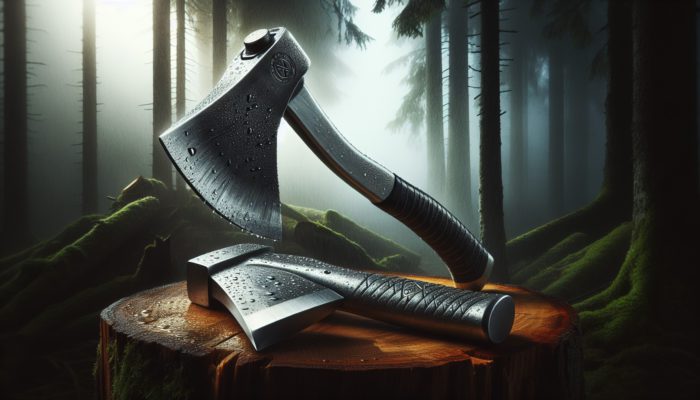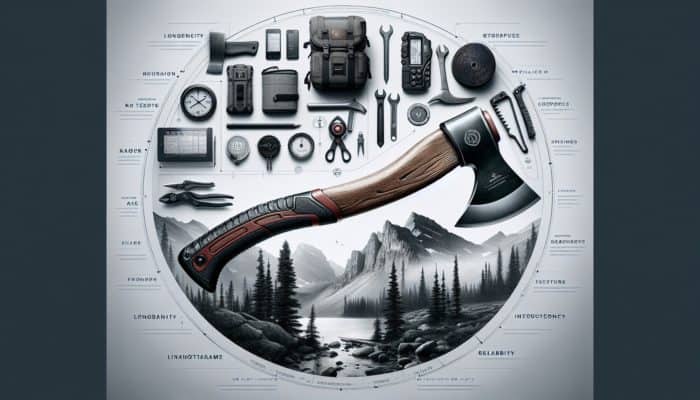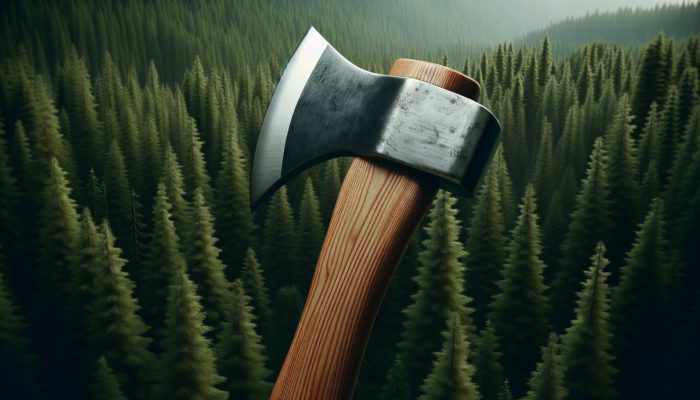Essential Characteristics of Survival Axes for Outdoor Enthusiasts
Understanding Blade Quality and Longevity

Survival Axe Reviews: The quality and durability of a survival axe’s blade are critical for ensuring its effective performance in real-world situations. Factors such as the material composition, manufacturing process, and design significantly influence the axe’s cutting efficiency and longevity under rigorous conditions. For example, a blade crafted from high-carbon steel is renowned for its superior hardness and edge retention, making it an ideal choice for demanding outdoor adventures. On the other hand, Stainless Steel offers excellent corrosion resistance, which is particularly important in humid or wet environments.
When assessing blade materials, consider the following commonly used types:
- High Carbon Steel
- Stainless Steel
- Tool Steel
- Alloy Steel
- Carbon Composite
- Damascus Steel
Each of these materials presents unique benefits; for instance, high-carbon steel excels in sharpness and ease of sharpening, whereas stainless steel is outstanding in resisting rust formation.
Additionally, the specific type of grind on the blade can influence performance. A convex grind is typically stronger and more effective for chopping, while a flat grind allows for increased precision during slicing tasks. Understanding these features ensures that you select an axe that fits your specific requirements, whether you’re camping in the lush forests of Canada or navigating the rugged landscapes of Patagonia.
Prioritising Handle Design and User Comfort
The handle of a survival axe is vital for ensuring user comfort and safety during operation. An ergonomically designed handle should fit comfortably in the hand, enabling the user to wield the axe without undue strain or the risk of slippage. Common materials utilised for axe handles include wood, fibreglass, and various forms of plastic or rubber composites. Each of these materials brings its own set of advantages; for instance, wooden handles are excellent for shock absorption, while fibreglass is lightweight and resistant to various weather conditions.
The length of the handle also plays a crucial role in the axe’s functionality. A longer handle provides increased leverage and power during swings, making it particularly effective for tasks that require chopping or other similar movements. However, it may prove less manoeuvrable in confined spaces or while undertaking more delicate tasks. Conversely, a shorter handle allows for greater precision but might not deliver the same amount of force. Therefore, understanding the intended use of the axe can help you select the appropriate handle length for your adventures.
Exploring Additional Tools and Accessories
Numerous survival axes come equipped with integrated tools and accessories that broaden their functionality beyond mere chopping. These additional features can distinguish a standard axe from a versatile survival tool. For instance, an axe might incorporate a built-in compass, which can aid in navigation during wilderness excursions, or a fire starter that ensures you can ignite a flame in emergencies.
Other valuable accessories may include:
- Whistles for signalling
- Built-in bottle openers
- Integrated saw blades
- Sheath or carrying case
- Multi-tool functionalities
- Paracord handles
These enhancements are particularly advantageous in survival scenarios where every tool counts. An axe equipped with a whistle can be crucial for attracting attention during emergencies, while an integrated saw blade adds versatility for tasks such as clearing pathways or constructing shelters. The incorporation of such features transforms a survival axe into a more comprehensive tool in outdoor environments.
How to Select the Ideal Survival Axe for Your Needs?

Evaluating Your Specific Requirements
Choosing the right survival axe starts with a thorough understanding of your specific needs. The primary use of the axe should drive your decision-making—whether you’re planning to use it for camping, emergency preparedness, or general outdoor adventures. Each application has unique requirements. For example, if your main goal is camping, you may prefer a lighter axe that’s easy to transport yet capable of handling wood chopping and tent stakes. In contrast, if you’re gearing up for emergencies, a more robust axe designed to withstand extreme conditions would be indispensable.
Key factors to consider when selecting an axe include its intended purpose, the environment in which it will be used, and the types of tasks it will need to perform. For instance, if you anticipate using the axe in wet conditions, a stainless-steel blade may be the best option, whereas a camping axe might benefit from a lightweight design. Identifying your specific scenarios will streamline your selection process, ensuring you choose an axe that aligns perfectly with your requirements.
Weighing Weight and Portability Considerations
Weight and portability are crucial factors to consider when selecting a survival axe. The weight of an axe greatly influences how easily it can be carried and used in various environments. For example, while a heavier axe may provide more power during chopping, it can quickly become cumbersome during extended hikes or when secured to a backpack.
It’s vital to find a balance between weight and functionality. A lightweight axe offers superior portability, making it suitable for backpacking through the rugged trails of the Appalachian Mountains or the expansive landscapes of the Scottish Highlands. Conversely, a heavier axe may be more appropriate for base camp setups where the focus is on power rather than mobility.
When assessing weight, consider the specific tasks you plan to undertake. For instance, if you require an axe for constructing shelters or performing heavy-duty chopping, a slightly heavier model may serve you better. However, for general camping tasks, a lightweight axe would suffice. Understanding the impact of weight on usability can lead to more informed decisions in selecting the perfect survival axe for your adventures.
Understanding Budget Constraints

Budget considerations are pivotal in selecting a survival axe, as prices can vary widely based on brand, materials, and features. While it might be tempting to opt for the most affordable option, it is crucial to weigh the features against the cost to find the best value for your needs. Higher-priced models often feature superior materials, enhanced durability, and additional functionalities, which can justify the investment in the long run.
When evaluating features that warrant a higher price, consider aspects like blade quality, handle ergonomics, and integrated tools. A well-constructed axe featuring a high-quality blade will outlast cheaper alternatives, making it a wise long-term investment. Seek out axes that come with a solid warranty, as this often indicates the manufacturer’s confidence in their product’s durability.
Conversely, there are budget-friendly options that still deliver solid performance without compromising quality. These axes are typically produced by reputable brands known for their craftsmanship. Researching and comparing options within your budget helps ensure you won’t sacrifice quality even when opting for a lower price point. Striking the right balance between cost and performance is crucial for making an informed purchasing decision.
Assessing Axe Materials and Durability
The materials used in the construction of a survival axe significantly influence its durability and performance. When evaluating an axe, it’s vital to consider the blade material, handle construction, and overall build quality. For blades, high carbon steel and stainless steel are popular choices, each offering unique strengths. High carbon steel is revered for its sharpness and ease of sharpening, while stainless steel provides exceptional corrosion resistance, which is crucial in humid or wet environments.
The handle material also contributes significantly to the axe’s overall durability. Wooden handles can offer excellent shock absorption but may be susceptible to moisture damage over time. In contrast, fibreglass handles are lightweight and resistant to environmental wear, while rubberized grips enhance comfort and prevent slippage during use. Understanding the trade-offs between materials enables you to choose an axe that aligns with your specific needs.
In addition to material selection, it’s essential to inspect the overall build quality. Look for indicators of craftsmanship, such as tight fittings where the handle meets the blade and the absence of gaps or defects. A well-constructed axe will not only perform better but will also have a longer lifespan, making it a worthwhile investment for outdoor enthusiasts.
Insights from Experts on Survival Axe Reviews
Material Choices and Their Impact on Performance
The selection of materials is crucial for the performance of survival axes. Different materials offer varying performance characteristics that can significantly affect usability during outdoor activities. For instance, blades made of high-carbon steel are celebrated for their edge retention and sharpness, making them ideal for demanding tasks such as chopping hardwoods or constructing shelters. In contrast, stainless steel provides enhanced rust resistance, making it the preferred choice for environments where moisture is prevalent, such as rainy forests or coastal areas.
Real-world examples underscore the importance of selecting the right material. In field tests, axes with high-carbon blades consistently demonstrated superior sharpness retention after prolonged use compared to their stainless steel counterparts. However, users noted that high-carbon blades required more maintenance to prevent rust, particularly when used in wet conditions. This highlights the necessity of matching material choice to the environment in which the axe will be employed.
Furthermore, advancements in manufacturing have led to the introduction of composite materials that combine the best attributes of both worlds. Such materials can provide superior durability without sacrificing weight, making them increasingly popular among serious outdoor enthusiasts. Selecting an axe crafted from high-quality materials tailored to your intended use will guarantee optimal performance in the field.
Maintenance Routines for Longevity
Proper maintenance of your survival axe is vital to ensure its longevity and optimal performance. Regular care not only extends the axe’s lifespan but also enhances its usability during critical moments. Start by cleaning the blade thoroughly after each use to eliminate dirt, sap, and moisture. A simple solution of warm water and mild soap is often adequate. After cleaning, dry the axe meticulously to prevent rust formation, especially if it features a high-carbon steel blade.
Sharpening the blade is another essential maintenance activity. A dull blade can impede performance and elevate the risk of accidents. Employ a sharpening stone or a specialised axe sharpener to maintain a keen edge. Strive for a consistent angle while sharpening to preserve the blade’s geometry. Regularly inspect for any nicks or chips and address them promptly to avoid further damage.
Additionally, examine the handle for any signs of wear, such as cracks or splinters. A loose handle can pose safety risks during operation. If you identify any issues, consider applying wood glue or replacing the handle entirely. Engaging in proper maintenance not only keeps your axe in prime condition but also ensures that it remains a reliable tool when you need it most.
Recommendations from Industry Experts
When selecting the best survival axes available on the market, expert recommendations hold significant value. Experts assess axes based on various criteria, including material quality, ergonomic design, weight, and versatility. For example, many experts favour axes that blend traditional craftsmanship with modern materials, as this combination often strikes the ideal balance between durability and usability.
A notable example includes brands that have established a reputation for quality, such as Fiskars and Gransfors Bruks. These companies are esteemed for their commitment to producing reliable tools that withstand the test of time. Expert reviews consistently emphasize the importance of user feedback in evaluating performance, especially in real-world settings.
Beyond brand reputation, experts also stress the significance of versatility. Axes that feature additional functionalities, such as integrated tools for fire-starting or compact designs for portability, are often recommended for their practicality in survival scenarios. By focusing on expert evaluations, you can make a more informed decision when selecting a survival axe that meets your specific needs.
Maximising Versatility with Additional Features
The versatility of survival axes is among their most appealing attributes, particularly when considering their additional functionalities. Many contemporary survival axes are engineered not only for chopping but also for a variety of tasks that can be vital in outdoor settings. For instance, axes outfitted with integrated fire starters allow users to quickly ignite a flame in emergencies, significantly enhancing their survival capabilities.
Additional beneficial features may include:
- Built-in compasses for navigation
- Multi-tools for added utility
- Whistles for signalling
- Sheaths or cases for safe transport
- Paracord-wrapped handles for added functionality
- Integrated saw blades for cutting versatility
These added functionalities greatly enhance the utility of a survival axe. For example, a whistle can prove invaluable during emergencies, enabling you to signal for help without straining your voice. Similarly, a compass is essential for navigation when lost in the wilderness.
The combination of a primary axe function with these additional features ensures that you possess a well-rounded tool capable of addressing multiple needs in survival situations. Therefore, selecting an axe that incorporates versatile features not only optimises your toolset but also enhances your preparedness for unexpected challenges during outdoor excursions.
Insights from User Experiences and Field Testing
Real user experiences and field testing provide invaluable insights into the effectiveness and reliability of various survival axes. By examining firsthand accounts, prospective buyers can gain a comprehensive understanding of how different axes perform in practical situations. User reviews frequently highlight specific scenarios, such as camping trips, survival training, or emergency preparedness exercises, where the axes were rigorously tested.
For instance, users often report on the effectiveness of specific axe models during heavy-duty chopping tasks. A recurring observation is that axes featuring high-carbon steel blades excel in cutting through dense wood, thereby making them ideal for constructing shelters or gathering firewood. However, users also acknowledge that maintenance is crucial; those who diligently sharpen and clean their axes report exceptional performance over time.
Field testing frequently reveals strengths and weaknesses that may not be apparent from standard product descriptions. For example, users have noted that some axes, although lightweight and portable, may struggle with heavier tasks, such as felling trees. Conversely, heavier axes, even if more challenging to carry, often outperform in demanding situations. These insights from actual use enable potential buyers to make informed decisions about which survival axe best suits their unique needs and usage scenarios.
What Are the Key Advantages of Owning a Survival Axe?
Unmatched Versatility in Outdoor Activities
A survival axe offers unparalleled versatility for a diverse range of outdoor activities, establishing it as an essential tool for both enthusiasts and casual adventurers alike. Whether you’re camping in the picturesque forests of Scandinavia or hiking the rugged trails of the Rockies, a quality survival axe can perform multiple functions beyond mere wood chopping. This single tool can assist with tasks such as constructing shelters, preparing firewood, and even crafting tools or utensils from natural materials.
Many survival axes are designed to be compact and portable, allowing outdoor enthusiasts to carry them on extended trips without feeling encumbered. In scenarios where space is at a premium, such as backpacking, the ability of a single tool to fulfill multiple roles is particularly advantageous. This versatility ensures that users are well-equipped to address a broad spectrum of challenges while immersed in nature.
Moreover, the capacity to chop, slice, or craft can substantially enhance the overall enjoyment of outdoor activities. For instance, when establishing camp, a survival axe can streamline the process of gathering firewood, enabling you to focus on other essential tasks, such as cooking or appreciating the scenery. The multifunctionality of a survival axe not only enriches outdoor experiences but also fosters a sense of preparedness and confidence while in the wild.
Essential for Emergency Preparedness
Owning a survival axe is a critical component of emergency preparedness, particularly for those who frequently venture into remote or wilderness areas. In crises, having the right tools can mean the difference between safety and hardship. A survival axe serves multiple purposes that are invaluable in emergencies, such as clearing debris after a natural disaster, constructing makeshift shelters, or even creating signals for rescuers.
Specific scenarios underscore the importance of having a survival axe readily available. For instance, during unforeseen weather events like snowstorms or floods, a sturdy axe can facilitate clearing pathways or creating shelter from the elements. Furthermore, in survival situations where traditional assistance may be delayed, the axe can be utilised for both practical tasks and as a means of self-defence against wildlife.
Incorporating a survival axe into your emergency preparedness kit ensures that you’re better equipped to handle a wide variety of unexpected challenges. Its multifunctionality offers peace of mind, knowing that you possess a reliable tool to address emergencies that may arise in the wilderness or during natural disasters.
Enhancing Safety and Security During Outdoor Adventures
A survival axe can markedly enhance safety and security during outdoor excursions. Beyond its practical applications, an axe can also serve as a self-defence tool against potential threats, whether from wildlife or unwelcome human encounters. The presence of a survival axe instills a sense of security, allowing outdoor enthusiasts to explore with greater confidence.
For example, when hiking in regions known for wildlife, such as bears or mountain lions, having the ability to defend oneself can be crucial. While the primary function of an axe is not self-defence, its formidable presence can deter potential threats, allowing the user to feel more secure in remote environments.
Additionally, possessing a survival axe can cultivate a heightened awareness of one’s surroundings and the importance of preparedness. Carrying a trusted tool encourages users to remain vigilant and ready for unexpected challenges. This increased readiness often translates into better decision-making and enhanced safety practices while navigating through the wilderness.
Top-Rated Survival Axes Available Today
Best Overall Survival Axe for All Situations
In the realm of survival axes, the Gransfors Bruks Small Forest Axe consistently emerges as the top choice in expert reviews. This axe is celebrated for its outstanding craftsmanship, durable materials, and versatile functionality, making it a favourite among outdoor enthusiasts.
Notable features include:
- Hand-forged high-carbon steel blade for exceptional edge retention
- Ergonomically designed hickory handle for optimal comfort and control
- Weight of approximately 2 pounds, providing an ideal balance of portability and power
- Compact size, perfect for backpacking and camping excursions
This axe excels in a variety of tasks ranging from chopping firewood to crafting tools, and its thoughtfully designed handle allows for extended use without discomfort. Durable and reliable, the Gransfors Bruks Small Forest Axe stands as a trusted companion for anyone venturing into the wild.
Best Budget-Friendly Survival Axe Option
For those seeking an economical choice that does not compromise on quality, the Fiskars X7 Hatchet is an excellent alternative. This affordable axe offers a remarkable combination of performance and value, making it an ideal choice for both casual campers and outdoor enthusiasts.
Key features include:
- Lightweight design at just over 1 pound for easy portability
- Durable, rust-resistant stainless steel blade for longevity
- Innovative shock-absorbing handle for enhanced comfort during use
- Compact size that is perfect for backpacking
The Fiskars X7 Hatchet is designed for general outdoor tasks, ranging from cutting kindling to light chopping. Its affordability and dependable performance make it a top choice for anyone seeking a reliable axe without exceeding their budget.
Best Survival Axe for Heavy-Duty Applications
For tackling heavy-duty tasks, the Estwing E24A Sportsman’s Axe stands out as an exceptional choice. This axe is specifically engineered for tough environments, excelling in demanding conditions, making it ideal for serious outdoor enthusiasts.
Key strengths include:
- Forged steel construction for maximum durability and strength
- Leather grip that offers excellent control and comfort
- The weight is approximately 2.5 pounds for effective chopping power
- Balanced design that allows for efficient swings
The Estwing E24A is particularly suited for felling trees or processing larger logs, making it the go-to option for those requiring robust performance in rugged conditions. Its built-in durability ensures it can withstand the rigours of heavy use.
Lightweight and Portable Survival Axe Choice
For adventurers prioritising portability, the Gerber Bear Grylls Parang is a remarkable option. This axe combines minimal weight with essential functionality, making it perfect for on-the-go survival needs.
Noteworthy features include:
- Lightweight design at just 1.5 pounds for effortless carrying
- High-carbon stainless steel blade for superior sharpness and durability
- Integrated safety sheath for secure transport
- Ergonomic handle engineered for a comfortable grip during extended use
Ideal for backpackers and those seeking a compact solution for outdoor survival, the Gerber Bear Grylls Parang offers efficiency without the burden of excess weight. Its design enables it to handle various tasks while remaining lightweight and easy to transport.
How Do Survival Axes Compare to Other Outdoor Tools?
Survival Axes versus Machetes: Understanding the Differences
While both survival axes and machetes are invaluable tools for outdoor activities, they serve distinct purposes and excel in different scenarios. A survival axe is primarily designed for chopping and splitting wood, making it an indispensable tool for constructing shelters and preparing firewood. Its weight and design facilitate powerful swings, making it ideal for heavy-duty tasks.
Conversely, machetes are lighter and more versatile, excelling in tasks such as clearing brush or slicing through vegetation. Their long, thin blades allow for ease of manoeuvrability, enabling users to navigate dense undergrowth effectively. In situations that require clearing paths or cutting through thick brush, a machete may be the superior choice.
However, when it comes to splitting larger logs or performing tasks that demand more force, a survival axe surpasses the capabilities of a machete. This distinction underscores the importance of assessing your specific needs and environment when deciding between the two tools. In many instances, carrying both a survival axe and a machete can effectively complement each other during outdoor adventures.
Survival Axes versus Knives: Identifying Their Roles
Survival axes and knives are both essential tools in outdoor settings, yet they serve different functions and cater to different tasks. Knives are more compact and versatile, making them ideal for intricate work such as skinning game, carving wood, or preparing food. Their lightweight design enables easy transport and swift access, making them indispensable for everyday tasks in the wilderness.
In contrast, survival axes deliver more power and efficiency for chopping and splitting tasks. The weight and design of an axe allow for more forceful swings, making it easier to fell trees or split logs. While knives are vital for precision tasks, survival axes excel in heavy-duty chopping applications.
When considering which tool to carry, it often comes down to the intended use. For general camp tasks and food preparation, a knife is a versatile tool. However, for tasks involving larger wood processing or shelter construction, a survival axe is essential. Carrying both tools can provide a comprehensive arsenal that effectively covers a wide range of outdoor tasks.
Survival Axes versus Multi-Tools: A Comparative Analysis
Both survival axes and multi-tools offer versatility in outdoor applications, but differ in their functionalities. Multi-tools are designed to provide an array of built-in tools, including pliers, screwdrivers, and knives, making them incredibly handy for a variety of minor tasks. Their compact design allows for easy carrying, making them a staple for many adventurers.
On the contrary, survival axes excel in their primary function—chopping and splitting wood. While some multi-tools may include small blades or saws, they cannot match the efficiency or power of a dedicated survival axe. For tasks that require heavy-duty work, such as constructing shelters or processing firewood, a survival axe is indispensable.
Nevertheless, the two tools can complement one another effectively. Many outdoor enthusiasts carry both a survival axe for chopping tasks and a multi-tool for its versatility in handling smaller, varied tasks. This combination ensures that all bases are covered, addressing both heavy-duty needs and the finer details of outdoor adventures.
Strategies for Evaluating Survival Axe Reviews
Assessing Brand Reputation
Brand reputation is a critical factor when selecting a survival axe, as it often reflects the quality and reliability of the product. Reputable brands typically have established a history of producing durable tools and receiving positive user feedback. For instance, brands such as Gransfors Bruks, Fiskars, and Estwing are well-regarded for their commitment to quality and performance.
When examining brand reputation, consider customer feedback and expert reviews. Tools manufactured by well-known companies are generally more trustworthy, as these organisations invest in research and development to guarantee their products meet high standards. Moreover, brands that provide warranties or guarantees demonstrate confidence in their products, offering purchasers peace of mind.
A strong brand reputation can also help you differentiate between quality options and inferior ones that may not perform adequately in the field. Relying on established brands ensures that you are investing in a tool that has undergone rigorous testing and proven effective in various outdoor scenarios.
Interpreting User Reviews for Informed Decisions
Analysing user reviews plays a vital role in making informed choices about a survival axe. Reviews can offer practical insights into a product’s performance, usability, and durability based on real-world experiences. To discern genuine feedback from biased opinions, seek reviews that provide detailed accounts of specific tasks and scenarios, rather than generic impressions.
When evaluating user feedback, consider the overall rating in conjunction with the frequency of both positive and negative comments. A tool with numerous high ratings but a few consistent complaints may still warrant consideration, especially if the positive feedback emphasises features that are important to you. Additionally, take note of reviews from individuals who have used the axe in conditions similar to those you expect to encounter.
By carefully evaluating user reviews, you can gain a deeper understanding of how a survival axe performs in real-world applications. This knowledge equips you to make a more informed purchase that aligns with your specific needs, ensuring you select a reliable and effective tool for your outdoor adventures.
Staying Informed on New Product Releases: Staying informed about new survival axe releases is essential for outdoor enthusiasts seeking the best tools available. The market for outdoor gear is constantly evolving, with manufacturers introducing innovative designs and materials that enhance performance and functionality. Staying informed about these developments enables users to make educated choices when selecting an axe.
One effective way to stay updated is by following reputable outdoor gear websites, blogs, and forums, which often review new products and provide insights into the latest trends. Many brands also announce new models through their websites and social media channels, which can serve as valuable resources for consumers.
Additionally, attending outdoor expos or trade shows can provide firsthand access to the newest tools and technologies. Such events frequently feature demonstrations from manufacturers, allowing users to experience new products in action. By staying informed about the latest releases, you can ensure that you are equipped with the most effective and reliable survival axes available.
Essential Maintenance Tips for Survival Axes
Effective Cleaning and Sharpening Techniques
Regular maintenance is vital to ensure the longevity and efficiency of your survival axe. Cleaning the axe after each use helps prevent rust and preserves the sharpness of the blade. A mixture of warm water and mild soap typically suffices for cleaning, followed by thorough drying to eliminate moisture.
When it comes to sharpening, maintaining a sharp blade is crucial for optimal performance. Use a sharpening stone or file, ensuring you follow a consistent angle to preserve the blade’s geometry. Regularly inspect for nicks or chips and promptly address them to prevent further damage. Adhering to these cleaning and sharpening techniques will keep your survival axe in prime condition.
Recommended tools and products for axe maintenance include:
- Sharpening stone or file
- Mild soap for cleaning
- Soft cloth for drying
- Protective oil for rust prevention
Integrating these maintenance practices into your routine will ensure that your survival axe remains a dependable tool for years to come.
Optimal Storage Solutions for Longevity
Proper storage is crucial for protecting your survival axe from damage and maintaining its longevity. Improper storage can lead to rust, dull blades, or even accidents. Ideally, axes should be kept in a cool, dry location away from moisture. Utilising a protective sheath can shield the blade from damage and prevent accidental cuts during storage.
Wall-mounted racks or magnetic strips can also serve as effective storage solutions, keeping your axe accessible while protecting it from environmental elements. For travel, consider using a padded case to offer additional protection during transport, especially if you’re heading into rugged terrains.
Overall, prioritizing appropriate storage techniques helps maintain the axe’s condition and ensures it is ready for use whenever needed.
Repairing Common Axe Issues
Minor issues with a survival axe can often be repaired at home, extending its lifespan and usability. Common problems include a loose handle, a chipped blade, or minor rust spots. Addressing these issues promptly can prevent further damage and enhance the axe’s performance.
If you notice a loose handle, check the connection between the head and the handle to ensure a proper fit. If necessary, apply wood glue to secure a tight fit. For chipped blades, carefully use a sharpening stone or file to restore the edge, ensuring you maintain the correct angle during the process. Rust can be treated with a rust remover or by lightly sanding the affected areas, followed by the application of a protective oil to prevent future corrosion.
By being proactive and addressing these common issues, you can ensure that your survival axe remains a reliable tool for years of outdoor adventures.
Lubrication and Rust Prevention Techniques
Regular lubrication is essential for maintaining the functionality and longevity of your survival axe, particularly concerning the blade and any moving parts. Selecting the right lubricant can help prevent rust and ensure smooth operation. High-quality oils, such as mineral oil or specialty tool oils, designed for use with tools, are excellent options.
To effectively lubricate your axe, apply a thin layer of oil to the blade and moving parts after cleaning and drying. This practice not only offers protection against rust but also enhances the axe’s performance during use. Depending on your environment and frequency of use, lubricating your axe every few months can help maintain its condition.
Moreover, proper storage practices are crucial for preventing rust. Keeping the axe in a moisture-free environment and using protective sheaths can significantly extend its lifespan. By incorporating lubrication and rust prevention techniques, you will safeguard your survival axe against the elements and ensure it remains ready for any outdoor challenge.
Frequently Asked Questions
What exactly is a survival axe?
A survival axe is a versatile tool designed for outdoor activities, capable of chopping, splitting, and performing other critical tasks necessary for survival in wilderness environments.
How do I properly maintain my survival axe?
Regular maintenance includes cleaning the blade, sharpening it, inspecting for loose handles, and applying lubricant to prevent rust formation.
What are the best materials for a survival axe’s blade?
High-carbon steel and stainless steel are popular choices for blades due to their durability and edge retention, while hickory and fiberglass are common materials for handles.
Can a survival axe be used for self-defence purposes?
Yes, a survival axe can serve as a self-defence tool against wildlife or potential threats, although its primary function is not self-defence.
What factors should I consider when purchasing a survival axe?
Evaluate factors such as intended use, weight, material quality, additional features, and budget to select the right axe for your specific needs.
What is the ideal weight for a survival axe?
The weight of a survival axe varies based on its intended use, but a range of 1.5 to 3 pounds is common for achieving a balance between usability and power.
Which survival axe is deemed best for camping purposes?
The Gransfors Bruks Small Forest Axe is highly regarded for its versatility and lightweight design, rendering it an excellent choice for camping excursions.
How do I sharpen a survival axe effectively?
Utilise a sharpening stone or file while maintaining a consistent angle to restore the blade’s edge, ensuring optimal performance during use.
What additional features should I seek in a survival axe?
Look for features such as integrated tools, ergonomic handles, and protective sheaths that enhance the axe’s functionality and ease of use.
Are budget-friendly survival axes reliable options?
Yes, numerous budget-friendly survival axes, such as the Fiskars X7, deliver solid performance and reliability without sacrificing quality, making them suitable for casual users.
Explore our world on X!
Survival Radio Options: Essential Gear for Emergencies
Comprehensive Guide to Different Types of Survival Radios Portable Handheld Radios for Emergency Situations Survival Radio Options: Portable handheld radios are essential components of any effective survival strategy, providing unparalleled portability and user-friendliness during emergencies. These devices are specifically engineered to be lightweight, making them perfect for activities like hiking, camping, or preparing for unforeseen […]
Emergency Radio Picks: Your Universal Survival Guide
Comprehensive Guide to Emergency Radio Picks: Stay Informed During Crises What Are Emergency Radio Picks and Their Significance? Emergency Radio Picks: These devices are meticulously engineered to receive important broadcasts during crises, ensuring that individuals remain updated when standard communication channels fail. These radios are indispensable tools that provide vital information about weather emergencies, natural disasters, […]
Survival Watch Features: Essential Tools for Adventure
Essential Features to Look for in Survival Watches Mastering Navigation with Compass Features Survival Watch Features: Survival watches frequently incorporate a built-in compass, a vital tool for navigating through challenging landscapes such as dense forests, rugged mountains, or vast deserts. A compass empowers users to stay on course, even when visual landmarks are scarce or […]
Surviving Without Fuel: Essential Strategies
Exploring the Fundamentals of Fuel-Free Living What Is the Concept of Living Without Fuel? Surviving Without Fuel: The concept of living without fuel centers on the pivotal goal of significantly reducing or entirely eliminating our dependence on conventional energy sources, such as gasoline and diesel. This lifestyle choice underscores the importance of adopting sustainable alternatives […]







